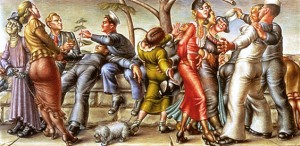
Rick has sent along some fascinating info about a key backstory for On the Town. Apparently, the Paul Cadmus painting above was the original inspiration for the Jerome Robbins ballet Fancy Free, which gave rise to the Bernstein-Comden-Green-Robbins Broadway production of On the Town, later to be adapted for the Hollywood Stanley Donen/Gene Kelley movie version.
That’s a fascinating history in a number of respects. It reminds us that back of the relatively tame eroticism of the Donen/Kelley film, and of the captivity narrative the film constructed (good girl rescued by good boy from clutches of alluring but dangerous metropolis), lay the somewhat more licentious reality captured and aggrandized by Cadmus’s painting.
But it also points to an important institutional history that underlies much of the cultural creativity of New York in the 1940s. Cadmus’s painting was one of the many art works that were made possible during the Depression by funding from the federal government–in this case from the Public Works of Art Project, a predecessor to the better known Federal Arts Project of the WPA. You can read an engaging history of the institution in this article from Rick’s magazine Artes.
Many of the writers, artists, and intellectuals we’ll encounter in this course were similarly beneficiaries of the opportunities made available by the cultural patronage of the New Deal. That patronage played a crucial role in democratizing the arts and in providing access to countless talented young people who otherwise would have had few chances to begin their careers. Betty Smith, who worked for the Federal Theater Project, was among them. And a good case can be made that some of the ways her novel views the world of her childhood are indebted to ideas and attitudes she absorbed while working on the FTP.
But even as the artistic patronage of the New Deal left a lasting legacy, by the early 1940s, the key programs had ended or were on the decline. By the later 1940s, the political and cultural attitudes that enabled them had shifted. (One aspect of the change was the Red Scare of the later 1940s. Jerome Robbins, the choreographer of On the Town, who was responsible for the original idea of the musical, was among the artists called before the House Un-American Activities Committee and asked to testify about his knowledge of Communist associations in the theater community.) Both the influence and the decline of the New Deal program for cultural democracy can seen in the work of Betty Smith, and of other figures we’ll encounter this semester.
